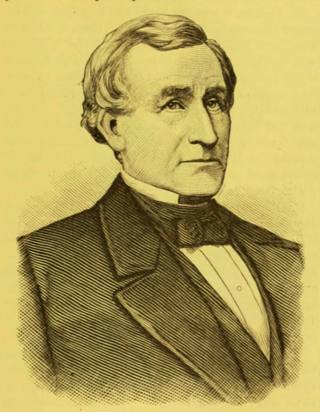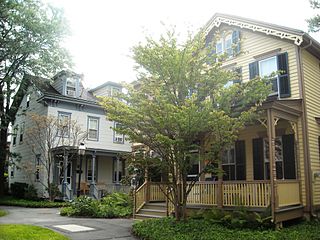
Charles Hodge was a Reformed Presbyterian theologian and principal of Princeton Theological Seminary between 1851 and 1878.

Archibald Alexander Hodge, an American Presbyterian leader, was the principal of Princeton Seminary between 1878 and 1886.

Archibald Alexander was an American Presbyterian theologian and professor at the Princeton Theological Seminary. He served for 9 years as the President of Hampden–Sydney College in Virginia and for 39 years as Princeton Theological Seminary's first professor from 1812 to 1851.

Princeton Theological Seminary (PTSem), officially The Theological Seminary of the Presbyterian Church, is a private school of theology in Princeton, New Jersey. Founded in 1812 under the auspices of Archibald Alexander, the General Assembly of the Presbyterian Church (USA), and the College of New Jersey, it is the second-oldest seminary in the United States. It is also the largest of ten seminaries associated with the Presbyterian Church.

Wisconsin Lutheran Seminary (WLS) is a post-secondary school that trains men to become pastors for the Wisconsin Evangelical Lutheran Synod (WELS). It is located in Mequon, Wisconsin.

The Princeton theology was a tradition of conservative Reformed and Presbyterian theology at Princeton Theological Seminary lasting from the founding of that institution in 1812 until the 1920s, after which, due to the increasing influence of theological liberalism at the school, the last Princeton theologians left to found Westminster Theological Seminary. The appellation has special reference to certain theologians, from Archibald Alexander to B. B. Warfield, and their particular blend of teaching, which together with its Old School Presbyterian Calvinist orthodoxy sought to express a warm evangelicalism and a high standard of scholarship. W. Andrew Hoffecker argues that they strove to "maintain a balance between the intellectual and affective elements in the Christian faith."

John Williamson Nevin, was an American theologian and educationalist. He was born in the Cumberland Valley, near Shippensburg, Franklin County, Pennsylvania. He was the father of noted sculptor and poet Blanche Nevin.

The Nassau Presbyterian Church is a historic congregation located at 61 Nassau Street in Princeton, New Jersey, United States. It has been the home of many important figures in the history of Presbyterianism in the United States as a result of its proximity to Princeton University and the Princeton Theological Seminary. The church operates the Princeton Cemetery and is a contributing property to the Princeton Historic District. The current pastor is The Reverend Dr. David A. Davis.

Old Queens is the oldest extant building at Rutgers University and is the symbolic heart of the university's campus in New Brunswick in Middlesex County, New Jersey in the United States. Rutgers, the eighth-oldest college in the United States, was founded in 1766 during the American colonial period as Queen's College. Queen's College was named for Charlotte of Mecklenburg-Strelitz, the daughter of a German duke who became the queen consort of British king George III. Old Queens is located on a six-acre hilltop city block bounded by Somerset Street, Hamilton Street, College Avenue and George Street that was previously an apple orchard. Donated to the college in 1807 by James Parker, Jr., this city block become known the Queen's Campus and is the historic core of the university. Because of this, by metonymy, the name "Old Queens" came to be used as a reference to Rutgers College and is often invoked as an allusive reference to the university or to its administration.
Princeton University was founded in Elizabeth, New Jersey, in 1746 as the College of New Jersey, shortly before moving into the newly built Nassau Hall in Princeton. In 1783, for about four months Nassau Hall hosted the United States Congress, and many of the students went on to become leaders of the young republic.

John Maclean Jr., D.D. was an American Presbyterian clergyman and educator who served as the tenth President of Princeton University, then known as the College of New Jersey. Maclean, the son of the first professor of chemistry at the College of New Jersey, grew up in Princeton, New Jersey. He attended the College and later Princeton Theological Seminary. At age 23, he became full professor of mathematics at the university. Six years later, he became university vice president. He was responsible for bringing a number of renown scholars and academics to the college. During this time, he also left mathematics and became professor of ancient languages. Maclean was one of the chief architects of the state's public education system. His plan for a state normal school, local boards of education and nonsectarian public schools was adopted by the state legislature. He became president of the College of New Jersey in 1854. He led the university through the 1855 burning of Nassau Hall and the American Civil War. After retiring from his post after 14 years in office, he wrote a two-volume history of the university. He served as the honorary president of the university's Alumni Association until his death.

Samuel Miller was a Presbyterian theologian who taught at Princeton Theological Seminary.

John Miller Dickey was an American Presbyterian minister. He and his wife, Sarah Emlen Cresson, a Quaker, founded Ashmun Institute on May 24, 1854, which was renamed Lincoln University (Pennsylvania) in 1866 following the assassination of President Abraham Lincoln. They named the school after Jehudi Ashmun, a religious leader and social reformer. They founded the school for the education and religious training of African American men, whose opportunities were limited. Lincoln University is the oldest historically black college or university in the United States.
The Princeton Theological Review is an annual academic journal published by students of Princeton Theological Seminary. It was first published with the title Biblical Repertory in 1825 by the Princeton Seminary graduate and professor, Charles Hodge. The name was changed to Biblical Repertory and Theological Review in 1829, Biblical Repertory and Princeton Review in 1837, Presbyterian Quarterly and Princeton Review in 1872, The Princeton Review in 1878, The Presbyterian Review in 1880, The New Princeton Review in 1886, The Presbyterian and Reformed Review in 1890, and finally Princeton Theological Review in 1903. In 1929 the trustees of Princeton Theological Seminary discontinued its subsidization. It was revived in the mid 1990s as The Princeton Theological Review. It again went dormant in 2012 but was revitalized in the 2014–2015 academic year.
James Franklin Kay is the Joe R. Engle Professor of Homiletics and Liturgics Emeritus, and Dean and Vice President of Academic Affairs Emeritus at Princeton Theological Seminary.

The First Presbyterian Church, known as "Old First", is a church located at 48 Fifth Avenue between West 11th and 12th Streets in the Greenwich Village neighborhood of Manhattan, New York City. It was built in 1844–1846, and designed by Joseph C. Wells in the Gothic Revival style. The south transept of the building was added in 1893–1894, and was designed by the firm of McKim, Mead & White. The church complex, which includes a parish house – now referred to as the "South Wing" – on West 11th Street and a church house on West 12th Street designed by Edgar Tafel, is located within the Greenwich Village Historic District.

Richardson Auditorium in Alexander Hall is a historic 900-seat Richardsonian Romanesque performance hall at Princeton University in Princeton, New Jersey. It is home to both the Princeton University Orchestra and the Princeton Symphony Orchestra.

The Princeton Historic District is a 370-acre (150 ha) historic district located in Princeton, New Jersey that was listed on the U.S. National Register of Historic Places in 1975. It stretches from Marquand Park in the west to the Eating Clubs in the East, from the Princeton Cemetery in the north to the Graduate College in the south. The district encompasses the core parts of the campuses of the Princeton Theological Seminary and Princeton University. It also includes the business district centered on Nassau Street and many historic homes, both mansions in the western section and more humble dwellings in the Witherspoon/Jackson neighborhood. Notable churches within the district include Nassau Presbyterian Church, Trinity Episcopal, Nassau Christian Center, and the Princeton University Chapel. The district is home to seven of Princeton's nine, and New Jersey's fifty-eight, National Historic Landmarks, the largest concentration of such sites in the state.

Charles Steadman (1790-1868) was an architect and builder in Princeton, New Jersey noted for his churches, university buildings, and especially private homes. He left a significant legacy of Greek Revival buildings at Princeton University, Princeton Theological Seminary, and in the surrounding town. He has been credited with "transform(ing) Princeton from a brick and stone village into a New-England-style town of wood and classical influences."
























